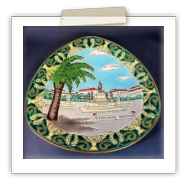Napoleon Bonaparte and Longwy, legend ?
From the Revolution to the July Monarchy, between 1789 and 1848, Longwy had five kings, three seats, two republics, an empire, and a three-year Prussian occupation. It was a rich and troubled period during which the city was visited by a duke, a prince, and even an emperor.
In 1798 a group of investors decided to set up a faience factory in a former convent on the banks of the river "Chiers" in Longwy. The beginnings are modest, but an unexpected event gives them the opportunity to make themselves known. On October 10, 1804, while traveling from Luxembourg to Stenay, Napoleon 1st visited the fortress of Longwy. Following its passage, a tureen decorated with the insignia of the Empire and the Legion of Honor is created.
Decade later, the end of the Empire is a difficult time. Seating and bombing follow epidemics and periods of occupation foreign to capitulations. The era is not conducive to trade, and marks a first break in the history of earthenware: in 1816 its owners yield to a member of the Boch family, which twenty years later associates his destiny to a family City of Metz in order to create the company Villeroy-et-Boch, whose links will then exist between the long-lived faience factory and its Luxembourg neighbor.
A century and a half later, the whole of France celebrates the bicentenary of Napoleon's birth. The Factory of Longwy, now autonomous and made famous by its famous glazes, is not left out. The management asks its best artists to produce a series of pieces inspired by major artistic works, representing the main events of the Emperor's life. Maurice-Paul Chevallier, Paul Mignon and Christian Leclercq make up 4 large cuts, which reflect their various sensibilities.



















